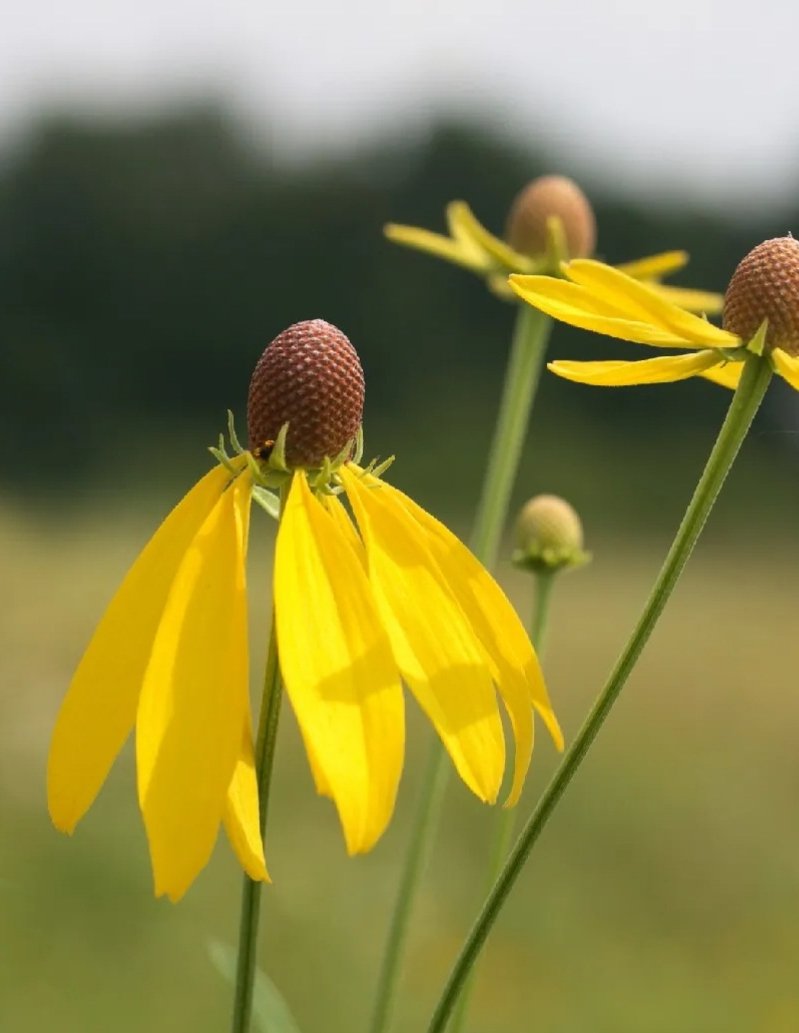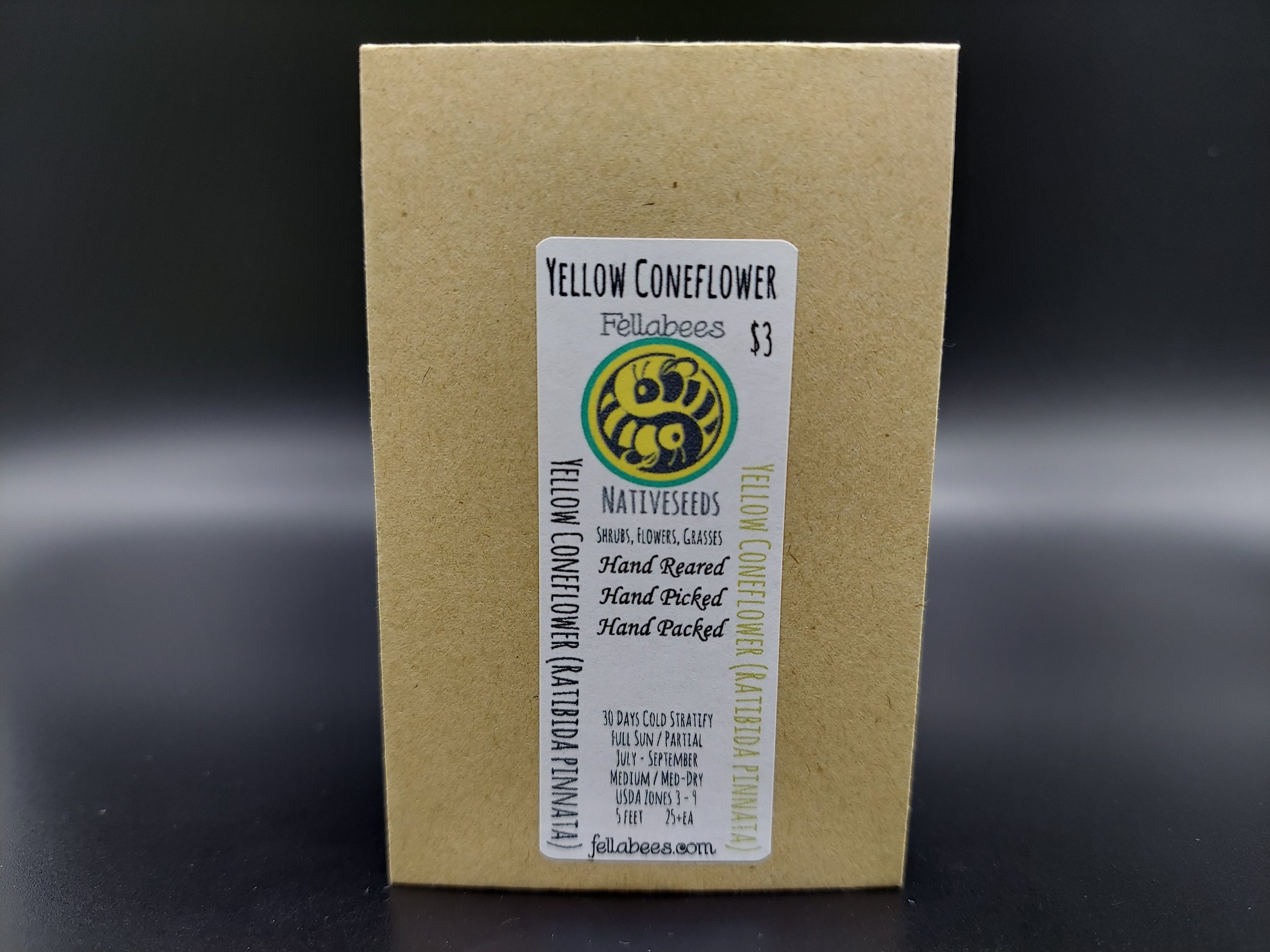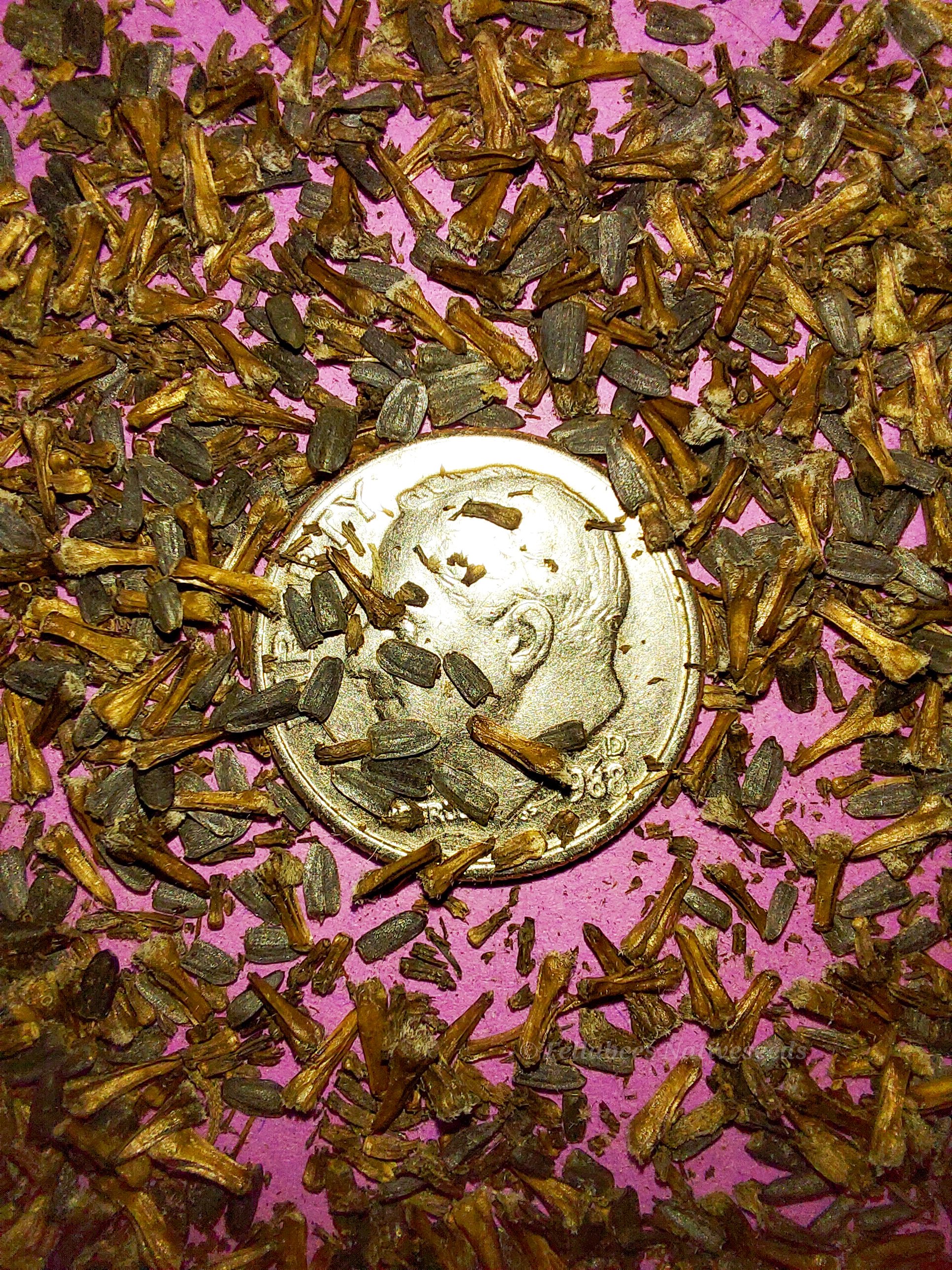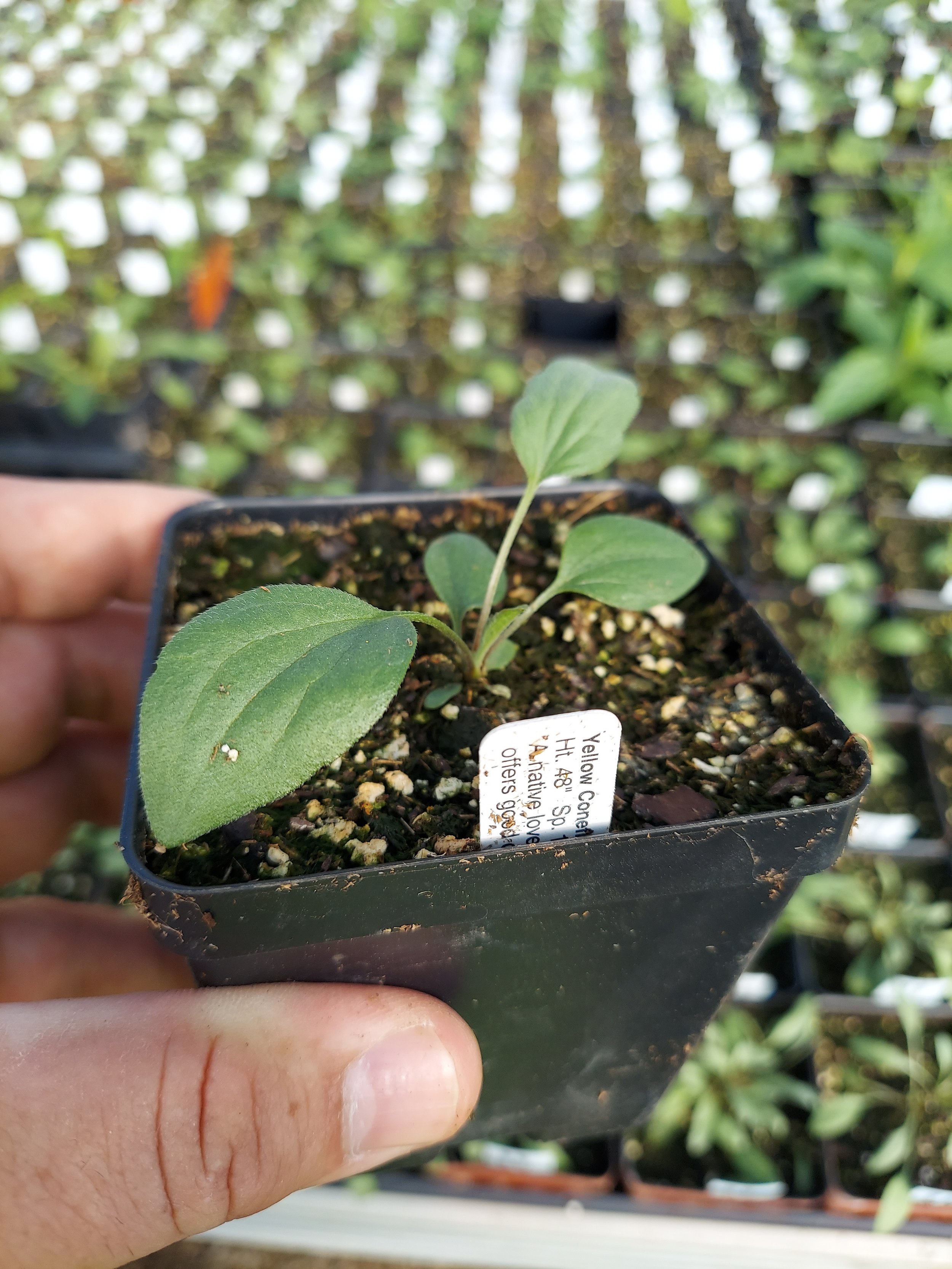Yellow Coneflower (Ratibida pinnata)
Yellow Coneflower (Ratibida pinnata)
Yellow Coneflower (Rattibida pinnata)
Ratibida pinnata is an endemic species of flowering plant in the family Asteraceae, more commonly known by the names Yellow Coneflower, Pinnate Prairie Coneflower, Gray-head Coneflower, and Prairie Coneflower. It is native to the central and eastern United States and Ontario in Canada.
This species is a perennial herb which can easily exceed 4 feet in height. It is a native that exceptionally easy to grow, and it works to compete with non-native plants, and is an excellent plant to start conservation with!
Yellow Coneflower has fibrous roots and will reproduce via seed and rhizomes. The rough-haired, glandular leaves are up to 16 inches long and are divided into several large lance-shaped or oval lobes. The inflorescences are tall, generally far above the highest leaves.
Each flower head contains up to 15 yellow ray florets up to 2 1⁄4 inches long. The center of the flower is globular or oval in shape and measures up to 1 inch long. It is covered in up to 200 or more disc florets which are yellow-green to purplish in color.
The disc heads have a scent reminiscent of anise (licorice) when crushed.
This plant greatfully grows in prairies, on the margins of woods, and on roadsides. It can grow in moist or dry habitat. It is hardy and not easily outcompeted by other non native plants.
This plant has grown as an ornamental garden plant. But it is best known for it's abilities to attract native bees, butterflies and songbirds.
This plant is considered present but rare in several counties of the states of North Dakota, South Dakota, Nebraska, Texas, Florida, South Carolina, and Pennsylvania.
Plant Details:
USDA Zones: 3-9
Germination Needs: 30 Day Cold Stratification
Life Cycle: Perennial
Sun Exposure: Full to Partial
Soil Moisture: Medium, Medium-Dry
Plant Spacing: 1½-2 feet
Height: 5 feet
Bloom Time: July, August, September
Bloom Color: Yellow
Advantages
Pollinator Favorite: butterflies, moths, bees, wasps, beetles
Bird Favorite: seeds, insects, fruit, nectar, nesting, perchs.
Deer Resistant: Yes
Excellent in the home landscape!
Native to or present in: Wisconsin, Minnesota, Iowa, Illinois, Indiana, Michigan, Ohio, Pennsylvania, New York, Vermont, Massachusetts, Connecticut, New Jersey, West Virginia, Virginia, Kentucky, Tennessee, South Carolina, Georgia, Florida, Alabama, Mississippi, Louisiana, Arkansas, Texas, Oklahoma, Arkansas, Missouri, Kansas, Nebraska, South Dakota and North Dakota.
.
.
Packet quantities:
We pride ourselves on ethical, hands on, ecological management, using no mechanical or chemical methods whatsoever.
All of our native seed is hand reared, hand picked, and hand packed from native prairies under our exclusive management, never breaking chain of custody from the field until it is sent to you. Each packet is hand prepared for shipment by us, directly.
Small seed species will contain greater than 20-25 seed
Large seed species will contain greater than 10-15 seed
It is our mission to spread the wealth of native plant and pollinator ecological sustainability, and educate back yard gardeners as well as corporate and government entities in how to germinate, grow, and benefit from native synergies.
Thank you for your support, it is because of you, that we can grow together to do, what we do.🐛🦋🐝🐞🌾🌱🌼🧡
Yellow Coneflower (Ratibida pinnata)
Yellow Coneflower (Rattibida pinnata)
Ratibida pinnata is an endemic species of flowering plant in the family Asteraceae, more commonly known by the names Yellow Coneflower, Pinnate Prairie Coneflower, Gray-head Coneflower, and Prairie Coneflower. It is native to the central and eastern United States and Ontario in Canada.
This species is a perennial herb which can easily exceed 4 feet in height. It is a native that exceptionally easy to grow, and it works to compete with non-native plants, and is an excellent plant to start conservation with!
Yellow Coneflower has fibrous roots and will reproduce via seed and rhizomes. The rough-haired, glandular leaves are up to 16 inches long and are divided into several large lance-shaped or oval lobes. The inflorescences are tall, generally far above the highest leaves.
Each flower head contains up to 15 yellow ray florets up to 2 1⁄4 inches long. The center of the flower is globular or oval in shape and measures up to 1 inch long. It is covered in up to 200 or more disc florets which are yellow-green to purplish in color.
The disc heads have a scent reminiscent of anise (licorice) when crushed.
This plant greatfully grows in prairies, on the margins of woods, and on roadsides. It can grow in moist or dry habitat. It is hardy and not easily outcompeted by other non native plants.
This plant has grown as an ornamental garden plant. But it is best known for it's abilities to attract native bees, butterflies and songbirds.
This plant is considered present but rare in several counties of the states of North Dakota, South Dakota, Nebraska, Texas, Florida, South Carolina, and Pennsylvania.
Plant Details:
USDA Zones: 3-9
Germination Needs: 30 Day Cold Stratification
Life Cycle: Perennial
Sun Exposure: Full to Partial
Soil Moisture: Medium, Medium-Dry
Plant Spacing: 1½-2 feet
Height: 5 feet
Bloom Time: July, August, September
Bloom Color: Yellow
Advantages
Pollinator Favorite: butterflies, moths, bees, wasps, beetles
Bird Favorite: seeds, insects, fruit, nectar, nesting, perchs.
Deer Resistant: Yes
Excellent in the home landscape!
Native to or present in: Wisconsin, Minnesota, Iowa, Illinois, Indiana, Michigan, Ohio, Pennsylvania, New York, Vermont, Massachusetts, Connecticut, New Jersey, West Virginia, Virginia, Kentucky, Tennessee, South Carolina, Georgia, Florida, Alabama, Mississippi, Louisiana, Arkansas, Texas, Oklahoma, Arkansas, Missouri, Kansas, Nebraska, South Dakota and North Dakota.
.
.
Packet quantities:
We pride ourselves on ethical, hands on, ecological management, using no mechanical or chemical methods whatsoever.
All of our native seed is hand reared, hand picked, and hand packed from native prairies under our exclusive management, never breaking chain of custody from the field until it is sent to you. Each packet is hand prepared for shipment by us, directly.
Small seed species will contain greater than 20-25 seed
Large seed species will contain greater than 10-15 seed
It is our mission to spread the wealth of native plant and pollinator ecological sustainability, and educate back yard gardeners as well as corporate and government entities in how to germinate, grow, and benefit from native synergies.
Thank you for your support, it is because of you, that we can grow together to do, what we do.🐛🦋🐝🐞🌾🌱🌼🧡
Yellow Coneflower (Ratibida pinnata)
Yellow Coneflower (Rattibida pinnata)
Ratibida pinnata is an endemic species of flowering plant in the family Asteraceae, more commonly known by the names Yellow Coneflower, Pinnate Prairie Coneflower, Gray-head Coneflower, and Prairie Coneflower. It is native to the central and eastern United States and Ontario in Canada.
This species is a perennial herb which can easily exceed 4 feet in height. It is a native that exceptionally easy to grow, and it works to compete with non-native plants, and is an excellent plant to start conservation with!
Yellow Coneflower has fibrous roots and will reproduce via seed and rhizomes. The rough-haired, glandular leaves are up to 16 inches long and are divided into several large lance-shaped or oval lobes. The inflorescences are tall, generally far above the highest leaves.
Each flower head contains up to 15 yellow ray florets up to 2 1⁄4 inches long. The center of the flower is globular or oval in shape and measures up to 1 inch long. It is covered in up to 200 or more disc florets which are yellow-green to purplish in color.
The disc heads have a scent reminiscent of anise (licorice) when crushed.
This plant greatfully grows in prairies, on the margins of woods, and on roadsides. It can grow in moist or dry habitat. It is hardy and not easily outcompeted by other non native plants.
This plant has grown as an ornamental garden plant. But it is best known for it's abilities to attract native bees, butterflies and songbirds.
This plant is considered present but rare in several counties of the states of North Dakota, South Dakota, Nebraska, Texas, Florida, South Carolina, and Pennsylvania.
Plant Details:
USDA Zones: 3-9
Germination Needs: 30 Day Cold Stratification
Life Cycle: Perennial
Sun Exposure: Full to Partial
Soil Moisture: Medium, Medium-Dry
Plant Spacing: 1½-2 feet
Height: 5 feet
Bloom Time: July, August, September
Bloom Color: Yellow
Advantages
Pollinator Favorite: butterflies, moths, bees, wasps, beetles
Bird Favorite: seeds, insects, fruit, nectar, nesting, perchs.
Deer Resistant: Yes
Excellent in the home landscape!
Native to or present in: Wisconsin, Minnesota, Iowa, Illinois, Indiana, Michigan, Ohio, Pennsylvania, New York, Vermont, Massachusetts, Connecticut, New Jersey, West Virginia, Virginia, Kentucky, Tennessee, South Carolina, Georgia, Florida, Alabama, Mississippi, Louisiana, Arkansas, Texas, Oklahoma, Arkansas, Missouri, Kansas, Nebraska, South Dakota and North Dakota.
.
.
Packet quantities:
We pride ourselves on ethical, hands on, ecological management, using no mechanical or chemical methods whatsoever.
All of our native seed is hand reared, hand picked, and hand packed from native prairies under our exclusive management, never breaking chain of custody from the field until it is sent to you. Each packet is hand prepared for shipment by us, directly.
Small seed species will contain greater than 20-25 seed
Large seed species will contain greater than 10-15 seed
It is our mission to spread the wealth of native plant and pollinator ecological sustainability, and educate back yard gardeners as well as corporate and government entities in how to germinate, grow, and benefit from native synergies.
Thank you for your support, it is because of you, that we can grow together to do, what we do.🐛🦋🐝🐞🌾🌱🌼🧡




